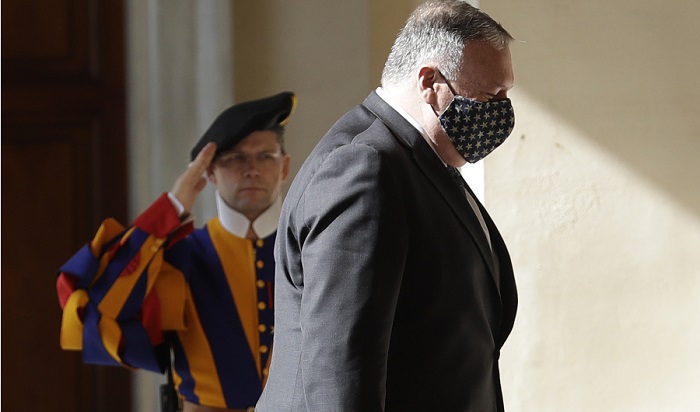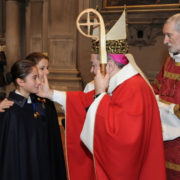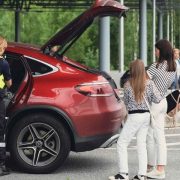
The recent visit of the U.S. Secretary of State Mike Pompeo to the Holy See in Rome was considered an attempt to drag Pope Francis into the American election. From the Holy See’s point of view, Pompeo tried to step into a controversy about the Catholic Church, where some American Catholics doubt the Pope’s “moral authority” for his choices on China and on many other issues, like the environment, concern about wild capitalism, or being open to areas traditionally considered non-Catholic.
Pompeo published an article critical of Francis’ policy on China on the American conservative Catholic journal First Things. But doubts about the Pope’s “moral authority,” especially if so bluntly expressed in a journal at times critical of Francis, in fact hardly belong to Catholic way of thinking, which strongly feels unity with the Pope. Pompeo’s criticism immediately sound “protestant,” as it ignores the role of the Pope, and therefore created a massive rally of the Church for the Pope and against outside criticism. Father Lorenzo Prezzi eloquently explained the feelings in Rome.
Yet this tiff may be highly misunderstood. There is no real difference in many of their concerns between the U.S. and the Holy See on China. Both are worried about growing repression in China, and about closure and an inward-looking spiral there. There is a difference of analysis, priorities, and options for solutions between the two, but it’s not like Washington is worried about China and Rome doesn’t think about it. The recent interview of the Vatican Secretary of State Pietro Parolin also stresses these points.
It is however impossible and credibly unhealthy to think of having America and the Holy See toeing the same line. Dialectic between different positions is healthy and keeps everybody on his toes.
The beauty of dialogue
Moreover, there is a true quandary: how come the U.S. and many countries think China is closing down while it is opening to its former arch enemy, the Vatican?
In fact, perhaps the ongoing new confrontation with China should push all to rethink how to see China and thus find new strategies about what to do. Getting the right vision for the moment is historically fundamental.
Is the picture flat and symbolic, like in the medieval icons? Is it a keen reproduction of reality, as with the Renaissance until the modern video screens? Or is it a deconstructed reproduction of perspective as with the cubists? Does it show the emptiness as with China Song paintings, or does it symbolize reality as in China Ming paintings? It mixes meaning and beauty as with calligraphy? The right vision for the moment might be a key.
Moreover, it is clear that the end of the Cold War and fall of the Soviet Empire didn’t mean that mental, economic, and political structures constructed at the end of World War II could be simply extended worldwide. If we want to use a popular image, many believed history then ended. Yes, perhaps a history ended, and another has to begin. This needs a common effort to rebuild the world and its institutions.
This new worldview has clearly pivoted to the Pacific and Asia, moving away from the Atlantic. In the old world, Europe was the center; now it can be a periphery. But it cannot be taken out of the picture altogether as happened in the early moments of the Trump presidency. Neither can Latin America or Africa be left out as accessories to something much more important. The ongoing troubles in Venezuela or the 10% a year GDP growth in Ethiopia prove they all must be woven into a new global vision.
After the revolution in virtual communication, through the internet and mobile phones, the next step is to bring people and things also physically closer. Logistics is another key. The success of the idea of the Chinese Belt and Road Initiative is that it tried to address this issue. There are open challenges, such as transportation across the American continent and Africa-Europe.
It is simply naïve to think that the world can be divided into different areas that are mutually isolated. Globalization, promoted by the U.S. in the 1990s, was based on the opposite concept: that the whole world was mutually interdependent and interactive. The internet revolution gave substance to this, and global physical and financial trade fed all of this.
Yet physical exchanges are lagging behind. Airports and airplanes are basically the same, with the same systems and same speed of the 1960s. Fast trains have been massively extended only in China; Japan basically still has the railways of 60 years ago, futuristic at the time; Europe just started scratching the surface with faster transportation. The rest of the world has stopped in the last century.
In all these areas, the U.S. perhaps can’t just tag along, it has to lead. But how and where? These answers will prove its leadership. Meanwhile, Pope Francis on the day of Saint Francis of Assisi, the Saint who during the Crusades went to talk to the Muslim Sultan, made his point in a new powerful encyclical work. It is about fraternity in this world.





